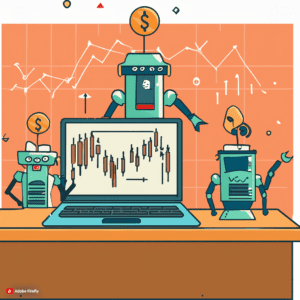
Advantages of using AI stock trading bots
One of the primary advantages of AI stock trading bots is their ability to operate 24/7, continuously monitoring the markets and executing trades in real-time. Additionally, these bots can process large volumes of data at high speeds, enabling them to identify trading opportunities that may be overlooked by human traders. AI stock trading bots are also immune to emotional biases and can stick to predefined trading strategies with discipline, eliminating the impulse-driven decisions that can lead to losses.
Risks and limitations of AI stock trading bots
While AI stock trading bots offer numerous benefits, they are not without risks. One of the primary concerns is the potential for overfitting, where the bot’s algorithms perform well in backtesting but fail to generalize to new market conditions. There is also the risk of technical glitches or errors in the bot’s programming, which can result in significant losses. Moreover, AI stock trading bots may struggle to adapt to sudden market changes or black swan events that deviate from historical patterns.
Best practices for using AI stock trading bots
To mitigate the risks associated with AI stock trading bots, it’s essential to follow best practices when using these tools. This includes thoroughly testing the bot’s algorithms in various market conditions, setting realistic expectations for performance, and regularly monitoring its activities. It’s also crucial to stay informed about market trends and developments, as well as any regulatory changes that may impact the use of AI stock trading bots.
Popular AI stock trading bot platforms
Several platforms offer AI stock trading bots for both retail and institutional investors. These platforms vary in terms of features, pricing, and performance. Some of the most popular AI stock trading bot platforms include Trade Ideas, QuantConnect, and AlgoTrader. Each platform has its unique strengths and weaknesses, so it’s essential to research and compare options before choosing one that best suits your needs.
Case studies
Numerous success stories attest to the effectiveness of AI stock trading bots in generating profits for investors. For example, Renaissance Technologies, one of the world’s most successful hedge funds, relies heavily on AI-driven trading strategies to achieve consistently high returns. Similarly, retail investors have reported significant gains using AI stock trading bots, leveraging their ability to analyze large datasets and identify profitable trading opportunities.
Regulatory considerations
As AI stock trading bots gain popularity, regulators are paying closer attention to their use in the financial markets. While these bots can offer benefits such as increased market efficiency and liquidity, there are also concerns about market manipulation and unfair advantages for certain investors. Regulators may impose stricter oversight and disclosure requirements for firms using AI stock trading bots to ensure fair and orderly markets.
Future trends in AI stock trading bots
Looking ahead, the future of AI stock trading bots looks promising. Advancements in AI technology, such as deep learning and reinforcement learning, are enabling bots to become even more sophisticated and adaptable. We can expect to see continued innovation in algorithmic trading strategies, as well as increased integration of AI into other areas of finance, such as risk management and portfolio optimization.
How to build an AI stock trading bot?
Building an AI stock trading bot involves several steps, from gathering data to implementing machine learning algorithms. Here’s a basic guide to get you started:
- Define Your Objectives: Determine the goals and objectives of your AI stock trading bot. Are you looking to automate trading strategies, optimize portfolio management, or identify profitable opportunities?
- Gather Data: Collect historical and real-time financial data from various sources, including stock prices, trading volumes, economic indicators, news articles, and social media sentiment. Ensure the data is clean, reliable, and relevant to your trading objectives.
- Preprocess Data: Clean and preprocess the data to remove noise, handle missing values, and normalize the features. This step is crucial for ensuring the quality of input data for training machine learning models.
- Feature Engineering: Extract relevant features from the data that can be used to predict stock prices or make trading decisions. This may involve technical indicators, fundamental metrics, sentiment analysis scores, and other derived features.
- Choose Machine Learning Algorithms: Select appropriate machine learning algorithms for your trading strategy, such as regression models, classification algorithms, or time series forecasting techniques. Consider using ensemble methods or deep learning models for complex patterns.
- Train the Model: Split the data into training and testing sets, and train the machine learning model using historical data. Optimize hyperparameters, tune the model architecture, and evaluate its performance using appropriate metrics.
- Backtesting: Validate the performance of the trained model using historical data through backtesting. Simulate trading strategies based on the model predictions and assess profitability, risk-adjusted returns, and other key metrics.
- Implement Trading Strategy: Integrate the trained model into a trading platform or brokerage API to execute buy or sell orders automatically. Implement risk management strategies, position sizing rules, and other trading parameters to control risk and maximize returns.
- Monitor and Iterate: Continuously monitor the performance of the AI stock trading bot in live trading environments. Analyze trading results, identify areas for improvement, and refine the model or trading strategy iteratively.
- Compliance and Regulation: Ensure compliance with relevant regulations and legal requirements governing algorithmic trading activities. Adhere to best practices for risk management, transparency, and fair trading practices.
- Building an AI stock trading bot requires a combination of domain expertise in finance, programming skills, and knowledge of machine learning techniques. It’s a complex and iterative process that requires careful planning, testing, and optimization to achieve consistent and profitable results.
Python Code for AI stock trading bot
Creating a fully functional AI stock trading bot involves a significant amount of code and complexity. However, I can provide you with a simplified Python script that demonstrates the basic structure and concepts of an AI stock trading bot using machine learning. Please note that this code is for educational purposes only and may require further customization and integration with trading platforms and APIs for live trading.
Code:
import pandas as pd
import numpy as np
from sklearn.model_selection import train_test_split
from sklearn.ensemble import RandomForestClassifier
from sklearn.metrics import accuracy_score
# Step 1: Gather and preprocess data
# Assume you have historical stock price data stored in a CSV file
data = pd.read_csv(‘stock_data.csv’)
# Preprocess data (cleaning, feature engineering, etc.)
# Step 2: Define features and target variable
features = [‘feature1’, ‘feature2’, ‘feature3’, …] # Define relevant features
X = data[features]
y = data[‘target_variable’] # Define target variable (e.g., buy/sell/hold signal)
# Step 3: Split data into training and testing sets
X_train, X_test, y_train, y_test = train_test_split(X, y, test_size=0.2, random_state=42)
# Step 4: Train machine learning model
model = RandomForestClassifier(n_estimators=100, random_state=42)
model.fit(X_train, y_train)
# Step 5: Evaluate model
y_pred = model.predict(X_test)
accuracy = accuracy_score(y_test, y_pred)
print(“Model Accuracy:”, accuracy)
# Step 6: Implement trading strategy
# Assume you have real-time data and want to make trading decisions based on model predictions
# You may need to integrate with a trading platform or brokerage API for live trading
def make_trading_decision(current_data):
# Extract features from current_data
features = extract_features(current_data)
# Make prediction using trained model
prediction = model.predict(features)
# Execute buy/sell orders based on prediction
execute_trade(prediction)
# Step 7: Monitor and iterate
# Continuously monitor the performance of the trading bot and refine the model/trading strategy as needed
This code demonstrates the basic workflow of building an AI stock trading bot using machine learning. However, building a robust and reliable trading bot for live trading requires additional considerations, such as data quality, model performance, risk management, and compliance with regulations. It’s essential to thoroughly test the trading bot in simulated environments before deploying it for live trading. Additionally, you may need to consult with financial experts and legal advisors to ensure compliance with relevant laws and regulations.
How to convert this code to apk file or in an android app?
To convert your Python code into an APK file that can be used on mobile devices, you’ll need to follow these general steps:
- Choose a Framework: Select a framework that allows you to package Python code into a mobile app. Some popular options include Kivy, BeeWare, and Pyqtdeploy.
- Install Necessary Tools: Install the necessary tools and dependencies for your chosen framework. This may include SDKs, compilers, and packaging tools.
- Configure Your Project: Set up your project structure and configure any required settings, such as app permissions and dependencies.
- Convert Python Code: Use the framework’s tools to convert your Python code into a format suitable for mobile deployment. This typically involves compiling the code and packaging it with the necessary runtime libraries.
- Build the APK: Use the framework’s packaging tools to build the final APK file for distribution. This process may vary depending on the framework you’re using.
- Test the App: Test the APK file on various Android devices to ensure compatibility and functionality.
- Distribute the App: Once you’re satisfied with the app’s performance, you can distribute the APK file through various channels, such as app stores or direct downloads.
Keep in mind that converting a Python script into a mobile app may require some modifications to your code, especially regarding user interface design and interaction. Additionally, performance considerations and platform-specific features may need to be addressed during the conversion process.
It’s also worth noting that while frameworks like Kivy and BeeWare allow you to build cross-platform apps that run on both Android and iOS, the process for deploying to iOS devices (i.e., iPhones and iPads) is more complex and may require additional steps, such as using a Mac computer and obtaining an Apple Developer account.
Overall, converting your Python code into a mobile app can be a rewarding process, but it does require some effort and familiarity with mobile app development concepts and tools.
Conclusion
AI stock trading bots represent a paradigm shift in the way investors approach the financial markets. By harnessing the power of artificial intelligence, these bots offer unparalleled speed, efficiency, and precision in executing trades. While there are risks and challenges associated with their use, the potential rewards are substantial for those who can harness their capabilities effectively.
FAQs
- What is the difference between an AI stock trading bot and a traditional trading bot?
- While both types of bots automate trading activities, AI stock trading bots leverage advanced algorithms and machine learning techniques to analyze data and make informed decisions, whereas traditional trading bots rely on preprogrammed rules.
- Can AI stock trading bots guarantee profits?
- No, AI stock trading bots cannot guarantee profits. While they can improve trading efficiency and identify potential opportunities, there are no guarantees in the financial markets, and losses are possible.
- Are AI stock trading bots suitable for beginners?
- AI stock trading bots can be complex to set up and require a certain level of technical expertise. Beginners may benefit from starting with simpler trading strategies and gradually incorporating AI tools as they gain experience.
- How much does it cost to use an AI stock trading bot?
- The cost of using an AI stock trading bot varies depending on the platform and the level of service. Some platforms offer subscription-based pricing models, while others charge a percentage of assets under management or per-trade fees.
- Are AI stock trading bots legal?
- Yes, AI stock trading bots are legal, but their use may be subject to regulatory oversight depending on the jurisdiction. It’s essential to comply with relevant laws and regulations when using these bots for trading activities.
Chek out our other article on stock market VWAP Indicator

